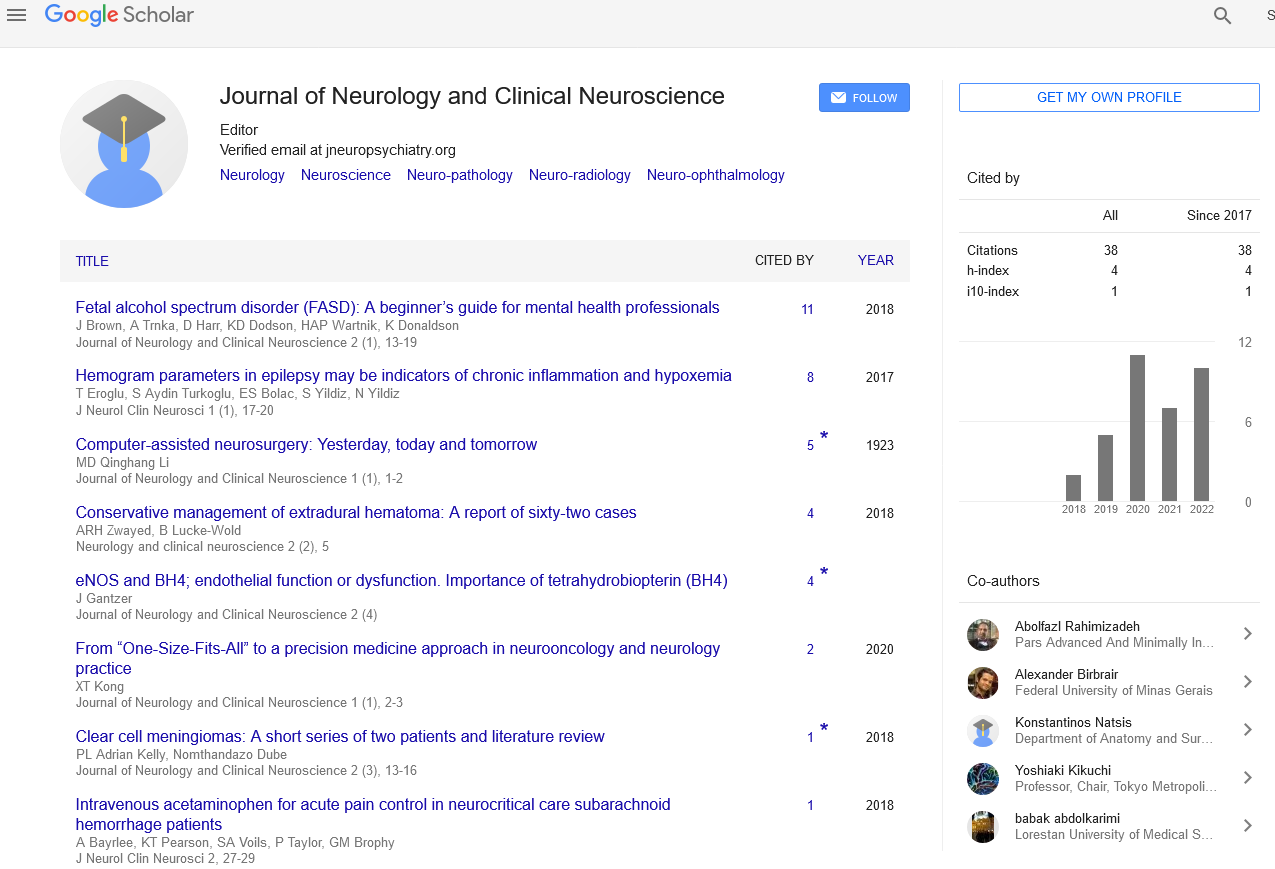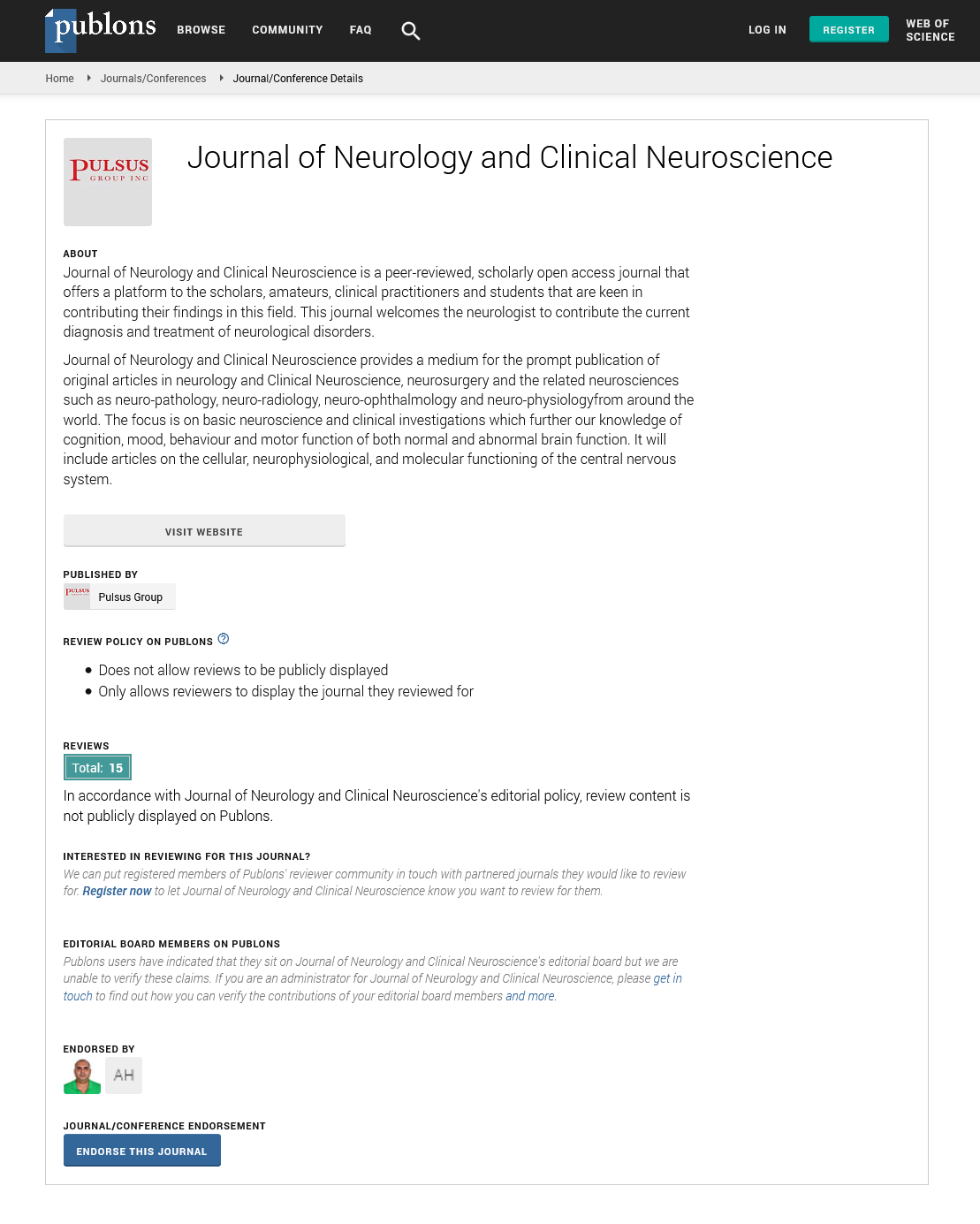Human cerebral cortex proteomic map: Global multiregional
Received: 20-Sep-2022, Manuscript No. PULJNCN-22-5368; Editor assigned: 22-Sep-2022, Pre QC No. PULJNCN-22-5368 (PQ); Reviewed: 04-Oct-2022 QC No. PULJNCN-22-5368 ; Revised: 27-Dec-2022, Manuscript No. PULJNCN-22-5368 (R); Published: 03-Jan-2023
Citation: Taylor J. Human cerebral cortex proteomic map: Global multiregional. J Neurol Clin Neurosci 2023;7(1):1-2.
This open-access article is distributed under the terms of the Creative Commons Attribution Non-Commercial License (CC BY-NC) (http://creativecommons.org/licenses/by-nc/4.0/), which permits reuse, distribution and reproduction of the article, provided that the original work is properly cited and the reuse is restricted to noncommercial purposes. For commercial reuse, contact reprints@pulsus.com
Abstract
One of the most used cortical maps for research of human brain functions and in clinical practice is the Brodmann Area (BA) based map; nevertheless, little is known about the molecular structure of BAs. By examining 29 BAs, the current work produced a worldwide multiregional proteomic map of the human cerebral cortex. Based on commonalities in proteomic patterns, these 29 BAs were divided into six clusters: the motor and sensory cluster, the vision cluster, the auditory cluster and Broca's area, the Wernicke's area cluster, the cingulate cortex cluster, and the cluster for heterogeneous function.
Keywords
Heterogeneous; Cytoarchitecture; Chromatography
Introduction
We discovered 134 BA specific signature proteins and 474 cluster specific signature proteins, whose functions are strongly related to the disease susceptibility and specialized functions of the respective cluster or BA. The results of this study may explain how the anterior cingulate cortex and sensorimotor cortex act together as well as how the sensorimotor cortex functions in relation to anxiety. The comparison of brain transcriptome and proteomic data suggested that while both may reflect cerebral cortex function, they did so in different ways. The human brain proteome atlas has these proteomic data available to the general audience. Our findings could improve our knowledge of the molecules underlying how the brain works and serve as a valuable tool for future research into the human brain. BAs are frequently linked to certain cortical processes. For instance, BAs 44 and 45 reliably localise Broca's speech and language area. Comprehensive human brain Magnetic Resonance Imaging (MRI) imaging histology and connectome maps have been researched, as well as the cytoarchitecture, imaging, and functional roles of BAs.
Literature Review
The BA based map has since grown in popularity as one of the cortical maps most frequently utilized in therapeutic settings and for research into brain functioning. BAs are frequently linked to certain cortical processes. For instance, BAs 44 and 45 reliably localise Broca's speech and language area. Comprehensive human brain Magnetic Resonance Imaging (MRI) imaging histology, and connectome maps have been researched, as well as the cytoarchitecture, imaging, and functional roles of BAs. A fuller knowledge of the molecular underpinnings of many brain activities will be possible with the help of molecular annotations, particularly at the protein level, of different BAs. To better understand the molecular underpinnings of the diverse cytoarchitectures and activities of different BAs, transcriptomic and proteomic maps of the brain have been created. The Allen Institute for Brain Science used microarrays to thoroughly profile almost 900 anatomically accurate subdivisions, leading to the creation of a transcriptional atlas of the human brain [1]. The molecular topography of the human neocortex is similar to its cytoarchitecture, and the transcriptional pattern of the neocortex is rather uniform. In the current study, a global multiregional proteomic map of the human cerebral cortex was created using 29 BA postmortem tissues [2]. An comprehensive proteome library of BA46 was initially created. Then, utilizing a 2- Dimension liquid chromatography mass spectrometry/mass spectrometry method along with Isobaric Tags for Relative and Absolute Quantification (iTRAQ) tagging, 29 BAs were quantitatively examined. 29 BAs were subjected to a clustering analysis based on similarity in protein expression patterns. Bioinformatics was used to find and examine proteins that exhibit the cluster and BA signatures. Proteomic information was used to functionally annotate the main functioning brain regions, including the cingulate cortex, motor cortex, sensory cortex, language area, and visual cortex. Additionally, the transcriptomes of the aforementioned BAs were examined, and the effects of the proteome and transcriptome on BA functions were compared. The national human brain bank for development and function, Chinese academy of medical sciences and Peking union medical college, Beijing, China, provided one human brain specimen for study. The 54 years old male willed donor who provided the brain sample died of lung cancer and had no prior history of brain metastases, injury, or other illnesses. Less than six hours passed after the death of the 29 BAs to collect their left cerebral hemisphere samples. The tissues were stained with hematoxylin and eosin (HE), which revealed that the brain was cancer free [3]. The Standardized Operational Protocol (SOP) of the Human Brain Bank of China served as the foundation for the protocols for acquiring brain tissue, dissecting it, and preparing samples, all of which were subject to constant and rigorous quality control. In previous proteomic investigations, BA46 (Dorsolateral Pre-Frontal Cortex, or DFC), which was extensively described, was found to be involved in a variety of cognitive processes. To create a Chinese reference brain protein library, deep proteomic profiling of BA 46 was done utilizing the 2DLC-MS/MS technique. In all, 8600 proteins were found in this investigation, which is equivalent to 73% and 89% of the proteins found in Kim et al.'s and Becky et al.'s analyses, respectively. Brain proteome study discovered 979 additional (11.4%) proteins for the first time [4-6].
Discussion
The proteome abundance in BA46 was determined using the Intensity-Based Absolute Quantification (iBAQ) approach to give a thorough characterization of protein abundance. 7129 proteins in total were successfully quantified, and the range of their abundances was 7 orders of magnitude. In the current study, high abundance brain proteins were defined as those present in greater than 4% of the most abundant proteins, which accounted for 292 proteins and 75% of the total protein abundance [7-10].
1513 proteins with mid-abundance and 5324 proteins with a low abundance made up the remaining 20% and 5% of the overall protein abundances, respectively. Specifically in the case of high abundance proteins, Gene Ontology (GO) research showed that nervous system structure and function were enriched in this brain proteome, suggesting the significance of high abundance proteins in brain functions [11].
Interarea variability (the difference between the highest and minimum ratios 2, described in materials and methods) was used to classify a total of 1241 proteins. These data are publically available, and the Human Brain Proteome Atlas (HBPA) was created to improve display and usage of them. The BAs in the cingulate cortex, subgenual cingulate cortex, and entorhinal cortex made up the cingulate cortex cluster (cluster 4). All of these BAs are part of the regions that connect the allocortex, which consists of three layers of neuronal cell bodies, to the neocortex (6 layers of neuronal cell bodies). Consequently, the cingulate cortex cluster's cytoarchitecture was different from the neocortexes [12].
Conclusion
As a result, the cingulate cortex cluster's cytoarchitecture was different from the neocortexes. It is possible that the proteome of the brain can reflect the differences in cytoarchitecture between the cingulate cortex and the neocortex because the cingulate cortex cluster was identified at the proteome level by protein patterns different from those of other clusters, which were primarily found in the neocortex. The remaining 23 BAs in the neocortex were divided into 5 clusters, and the BAs in each cluster had a similar functional makeup. The vision cluster (cluster 6), for instance, was made up of a collection of BAs (BAs 17, 18, 19, 37, and 34) involved in visual processing. BAs 17, 18, and 19 are situated in the occipital lobe, and BA37 is next to BA19. The four BAs line up with traditional visual processing zones.
References
- Hawrylycz MJ, Lein ES, Guillozet-Bongaarts AL, et al. An anatomically comprehensive atlas of the adult human brain transcriptome. Nature. 2012;489(7416):391-9.
[Crossref] [Google Scholar] [PubMed]
- Brodmann K. VergleichendeLokalisationslehre der Grosshirnrinde. Leipzig: Barth, 1909.
- Sharma K, Schmitt S, Bergner CG, et al. Cell type and brain region resolved mouse brain proteome. Nat Neurosci. 2015;18(12):1819-31.
[Crossref] [Google Scholar] [PubMed]
- Jung SY, Choi JM, Rousseaux MW, et al. An anatomically resolved mouse brain proteome reveals Parkinson disease-relevant pathways. Mol Cell Proteomics. 2017; 16(4):581-93.
[Crossref] [Google Scholar] [PubMed]
- Kim MS, Pinto SM, Getnet D, et al. A draft map of the human proteome. Nature. 2014;509(7502):575-81.
[Crossref] [Google Scholar] [PubMed]
- Carlyle BC, Kitchen RR, Kanyo JE, et al. A multiregional proteomic survey of the postnatal human brain. Nat Neurosci. 2017;20(12):1787-95.
[Crossref] [Google Scholar] [PubMed]
- Patel RS, Bowman FD, Rilling JK, et al. Determining hierarchical functional networks from auditory stimuli fMRI. Hum Brain Mapp. 2006; 27(5):462-70.
[Crossref] [Google Scholar] [PubMed]
- Qiu W, Zhang H, Bao A, et al. Standardized operational protocol for human brain banking in China. Neurosci Bull. 2019;35(2):270-6.
[Crossref] [Google Scholar] [PubMed]
- Mann K, Edsinger E. The Lottia gigantea shell matrix proteome: Re-analysis including MaxQuant iBAQ quantitation and phosphoproteome analysis. Proteome Sci. 2014;12(1):1-2.
[Crossref] [Google Scholar] [PubMed]
- Wilkerson MD, Hayes DN. ConsensusClusterPlus: a class discovery tool with confidence assessments and item tracking. Bioinform. 2010;26(12):1572-3.
[Crossref] [Google Scholar] [PubMed]
- Vogt BA, Nimchinsky EA, Vogt LJ, et al. Human cingulate cortex: surface features, flat maps, and cytoarchitecture. J Comp Neurol. 1995;359(3):490-506.
[Crossref] [Google Scholar] [PubMed]
- Hubbard EM, Ramachandran VS. Neurocognitive mechanisms of synesthesia. Neuron. 2005;48(3):509-20.
[Crossref] [Google Scholar] [PubMed]





